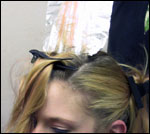Greetings, O Esteemed Umbra,
I decided a while ago that I wouldn’t put toxic chemicals down the drain for the sake of vanity. However, I’m a dirty, dirty blond (um, hair color) and was wondering if there is a “safe” way to add some highlights. Besides lemon juice, are there other products or substances that can be used to safely create that sunny look I’d like to have?
Dirty Hairy
Cincinnati, Ohio
Dearest Dirty Hairy,
A strand of hair consists of a cortex surrounded by a protective cuticle. The pigmented cortex is what makes you a dirty blond. It also holds your DNA and various proteins. The cuticle, a scaly covering, defends the cortex against all comers. (Selected strands of your hair also contain a “medula,” which has been described to me as “the kidney of the hair,” and is tangential to your question.)

Blonde ambitions.
In order to access the pigment in the cortex, hair-dye chemicals must first breach the cuticle. The rapid strike force begins with ammonia, which cracks the scaly walls and allows hydrogen peroxide to move into the cortex, where it shatters color molecules and “lifts” the pigment. Together, these two chemicals will bleach your hair. In hair dye, they are joined by whatever new pigment suits your fancy. Ammonia is nasty. It can irritate your eyes and lungs, and at extremely high concentrations (much higher than required to make you look like Britney), it can lead to everything from convulsions to coma. As I’ve explained to other readers, if something hurts you, it likely hurts others, who in this case include your hairdresser and the fish at the other end of the plumbing.
The need to crack the cuticle is what limits blonding to serious chemicals. Heat also does the trick, which is why we are always told to sit in the sun after applying lemon juice. Lemon juice (an acid) and over-the-counter hydrogen peroxide are the best and least toxic alternatives to ammonia dyes, but their effectiveness relies on heat and repeated applications. Put juice on your hair, blow it dry, add more juice, blow it dry, juice, dry, juice, dry, etc., etc., and eventually you’ll be blond. Even my brunette colorist achieved blond hair in high school with hydrogen peroxide using this technique, and she reluctantly shared with me this vital tip for home dyeing: Push through the orange stage. With enough time and patience, you will achieve blond.
In other hair-color news, hair-redecorating products have significantly lowered their ammonia content over the past 20 years, and if your hairdresser is a thinking person, she or he will be using less-toxic brands. Also, the herbal hair people have long lists of other plants and plant parts, ranging from chamomile to potato peels, that purportedly color or lighten your hair. A quick web search will find you some of these techniques, which I can’t vouch for and so won’t reference here. My colorist pooh-poohed them.
Lastly, the success of all these efforts will depend on your own personal hair. Some folks have genetically smoother cuticles that are harder to breach, while others have extremely porous hair. If you have trouble and don’t want to look punk, please consult an expert.
Shinily,
Umbra


